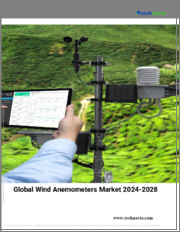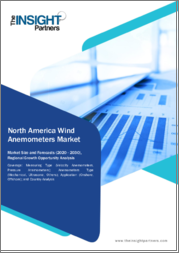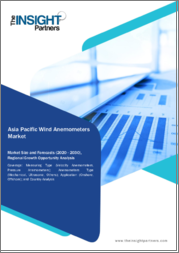
|
시장보고서
상품코드
1570824
세계의 풍속계 시장 : 기술별, 용도별, 최종 사용자별, 제품 유형별, 유통 채널별, 센서별, 조작별 - 예측(2025-2030년)Anemometer Market by Technology (Cup, Hot-Wire, Laser Doppler), Application (Agriculture, Commercial Use, Industrial), End-User, Product Type, Distribution Channel, Sensors, Operation - Global Forecast 2025-2030 |
||||||
풍속계 시장의 2023년 시장 규모는 477억 2,000만 달러로 평가되었고, 2024년에는 509억 6,000만 달러로 추정되며, CAGR 7.88%로 성장할 전망이고, 2030년에는 811억 7,000만 달러에 달할 것으로 예측됩니다.
풍속계는 풍속과 풍향을 측정하는 데 사용되는 중요한 기상 관측 장비이며, 기상학, 항공, 해양, 신재생 에너지, 건설 등 다양한 산업에서 용도가 있습니다. 풍속계의 필요성은 바람 관련 프로세스의 최적화, 특히 신재생 에너지 부문의 위치 평가 및 풍력 터빈의 성능 최적화에 있어 매우 중요한 역할을 하기 때문입니다. 최종 용도는 일기 예보 서비스, 공항, 항만, 풍력 발전소 등 다양합니다. 풍속계 시장 성장은 주로 신재생 에너지 부문의 확대, 정확한 기상 예보의 중시 증가, 항공 및 해상 업무 증가에 의해 초래됩니다. 청정에너지에 대한 세계 수요가 증가함에 따라 풍력터빈의 설치가 급증하고 효율화를 위해 정확한 풍속 측정이 필요하기 때문입니다. 적극적인 신재생 에너지 목표를 내세우는 중국과 인도의 신흥 시장은 유리한 기회를 제공합니다. 그러나 시장 성장에 영향을 미치는 과제로는 종래의 풍속계에 따른 높은 유지보수 비용, 극단적인 기상 조건 하에서의 기술적 한계, 낡은 모델이 무효가 되는 기술 진보의 페이스의 속도 등을 들 수 있습니다. 혁신은 실시간 데이터 분석을 위한 IoT 솔루션과 통합하여 향상된 기능 및 예측 유지보수 기능을 제공하는 내구성 있고 비용 효율적인 다중 파라미터 풍속계 개발에 중점을 둡니다. 소형화와 센서 기술의 향상으로, 소비자용 전자기기나 스마트 홈 디바이스에 대한 용도가 더욱 넓어질 가능성이 있습니다. 풍속계 시장은 성장하는 한편, 기술 변화와 규제 기준에의 지속적인 적응이 요구되고 있어, 경쟁을 유지하기 위한 계속적인 연구 개발의 필요성이 부각되고 있습니다. 기술의 진보를 활용함으로써 기업은 다양한 환경 조건에 적합한 보다 견고하고 스마트한 풍속계를 개발할 수 있어 궁극적으로 가치를 높여 시장의 밑단을 넓힐 수 있습니다.
| 주요 시장 통계 | |
|---|---|
| 기준년(2023년) | 477억 2,000만 달러 |
| 예측년(2024년) | 509억 6,000만 달러 |
| 예측년(2030년) | 811억 7,000만 달러 |
| CAGR(%) | 7.88% |
시장 역학 : 급속히 진화하는 풍속계 시장의 주요 시장 인사이트 공개
풍속계 시장은 수요 및 공급의 역동적인 상호 작용에 의해 변모하고 있습니다. 이러한 시장 역학의 진화를 이해함으로써 기업은 충분한 정보를 바탕으로 투자결정, 전략적 의사결정, 새로운 비즈니스 기회를 획득할 수 있습니다. 이러한 동향을 종합적으로 파악함으로써 기업은 정치적, 지리적, 기술적, 사회적, 경제적 영역에 걸친 다양한 리스크를 경감할 수 있어 소비자 행동이나 그것이 제조 비용 및 구매 추세에 미치는 영향에 대해서도 더 명확하게 이해할 수 있습니다.
Porter's Five Forces : 풍속계 시장을 탐색하는 전략 도구
Porter's Five Forces 프레임 워크는 시장 상황경쟁 구도를 이해하는 중요한 도구입니다. Porter's Five Forces 프레임 워크는 기업의 경쟁을 평가하고 전략적 기회를 탐구하는 명확한 기술을 설명합니다. 이 프레임 워크는 기업이 시장 내 세력도를 평가하고 신규 사업의 수익성을 결정하는 데 도움이 됩니다. 이러한 인사이트를 통해 기업은 자사의 강점을 활용하고 약점을 해결하고 잠재적인 과제를 피할 수 있으며 보다 강인한 시장에서의 포지셔닝을 확보할 수 있습니다.
PESTLE 분석 : 풍속계 시장에서 외부로부터의 영향 파악
외부 거시 환경 요인은 풍속계 시장의 성과 역학을 형성하는데 매우 중요한 역할을 합니다. 정치적, 경제적, 사회적, 기술적, 법적, 환경적 요인 분석은 이러한 영향을 탐색하는 데 필요한 정보를 설명합니다. PESTLE 요인을 조사함으로써 기업은 잠재적인 위험과 기회를 더 잘 이해할 수 있습니다. 이 분석을 통해 기업은 규제, 소비자 선호, 경제 동향의 변화를 예측하고 앞으로 예상되는 적극적인 의사 결정을 할 준비를 할 수 있습니다.
시장 점유율 분석 : 풍속계 시장 경쟁 구도 파악
풍속계 시장의 상세한 시장 점유율 분석을 통해 공급업체의 성과를 종합적으로 평가할 수 있습니다. 기업은 수익, 고객 기반, 성장률 등 주요 지표를 비교하여 경쟁 포지셔닝을 밝힐 수 있습니다. 이 분석을 통해 시장 집중, 세분화 및 통합 동향을 밝혀내고 공급업체는 경쟁이 치열해지면서 자신의 지위를 높이는 전략적 의사 결정을 내리는 데 필요한 지식을 얻을 수 있습니다.
FPNV 포지셔닝 매트릭스 : 풍속계 시장에서 공급업체의 성능 평가
FPNV 포지셔닝 매트릭스는 풍속계 시장에서 공급업체를 평가하는 중요한 도구입니다. 이 행렬을 통해 비즈니스 조직은 공급업체의 비즈니스 전략과 제품 만족도를 기준으로 평가하여 목표에 맞는 충분한 정보를 바탕으로 의사 결정을 내릴 수 있습니다. 네 가지 사분면을 통해 공급업체를 명확하고 정확하게 세분화하여 전략 목표에 가장 적합한 파트너 및 솔루션을 파악할 수 있습니다.
전략 분석 및 추천 : 풍속계 시장에서 성공을 위한 길 그리기
풍속계 시장의 전략 분석은 세계 시장에서의 현존 강화를 목표로 하는 기업에 필수적입니다. 주요 자원, 역량 및 성과 지표를 검토함으로써 기업은 성장 기회를 파악하고 개선을 위해 노력할 수 있습니다. 이 접근법을 통해 경쟁 구도에서 과제를 극복하고 새로운 비즈니스 기회를 활용하여 장기적인 성공을 거둘 수 있는 체제를 마련할 수 있습니다.
이 보고서는 주요 관심 분야를 포괄하는 종합적인 시장 분석을 제공합니다.
1. 시장 침투도 : 현재 시장 환경에 대해 상세히 검토합니다.
2. 시장 개척도 : 신흥 시장의 성장 기회를 파악하고, 기존 부문에서의 확장 가능성을 평가하며, 미래 성장을 위한 전략적 로드맵을 설명합니다.
3. 시장 다양화 : 최근 제품 출시, 미개척 지역, 업계의 주요 진보, 시장을 형성하는 전략적 투자를 분석합니다.
4. 경쟁 평가 및 정보 : 경쟁 구도를 철저히 분석하고 시장 점유율, 사업 전략, 제품 포트폴리오, 인증, 규제 당국 승인, 특허 동향, 주요 기업의 기술 진보 등을 조사했습니다.
5. 제품 개발 및 혁신 : 미래 시장 성장을 가속할 것으로 예상되는 최첨단 기술, 연구개발 활동, 제품 혁신을 강조합니다.
또한 이해관계자가 충분한 정보를 바탕으로 의사결정을 할 수 있도록 중요한 질문에도 답변하고 있습니다.
1. 현재 시장 규모 및 향후 성장 예측은?
2. 최고의 투자 기회를 제공하는 제품, 지역은 어디입니까?
3. 시장을 형성하는 주요 기술 동향 및 규제의 영향은?
4. 주요 벤더의 시장 점유율 및 경쟁 포지션은?
5. 벤더 시장 진입 및 철수 전략의 원동력이 되는 수익원과 전략적 기회는 무엇인가?
목차
제1장 서문
제2장 조사 방법
제3장 주요 요약
제4장 시장 개요
제5장 시장 인사이트
- 시장 역학
- 성장 촉진요인
- 신재생 에너지원 수요 증가가 풍속계의 도입 촉진
- 풍속계 설계의 기술적 진보에 의해 정밀도와 신뢰성 향상
- 풍력에너지 이용을 촉진하는 정부의 규제와 보조금 확대
- 농업이나 항공을 포함한 다양한 산업에 있어서의 풍속계 용도 확대
- 억제요인
- 시장 진입과 운영에 영향을 미치는 광범위한 규제 요건과 기준 준수
- 풍속계 제조에 있어서의 첨단 기술의 통합과 생산 공정에 관련하는 고비용
- 기회
- 풍속계 시장에서 혁신적인 기술 진보가 전례가 없는 성장 기회로 연결
- 신재생 에너지 부문에서의 풍속계의 용도 확대에 의한 효율과 성능 향상
- 기상 조사에 있어서의 정밀 측정 수요의 고조로 풍속계 시장의 확대 촉진
- 과제
- 급속한 기술 진보에 적응해, 풍속계 디자인에 신기능 통합
- 다양한 업계에서 높아지는 커스터마이즈 가능하고 용도 고유의 풍속계 수요에 대응
- 성장 촉진요인
- 시장 세분화 분석
- Porter's Five Forces 분석
- PESTLE 분석
- 정치
- 경제
- 사회
- 기술
- 법률
- 환경
제6장 풍속계 시장 : 기술별
- 서문
- 컵
- 핫 와이어
- 레이저 도플러
- 초음파
- 고정형
- 핸드헬드
제7장 풍속계 시장 : 용도별
- 서문
- 농업
- 상용이용
- 기상관측소
- 산업
- 연구
제8장 풍속계 시장 : 최종 사용자별
- 서문
- 건설
- 환경 모니터링
- 제조업
- 석유 및 가스
- 발전
제9장 풍속계 시장 : 제품 유형별
- 서문
- 고정식 풍속계
- 휴대용 풍속계
제10장 풍속계 시장 : 유통 채널별
- 서문
- 오프라인
- 온라인
제11장 풍속계 시장 : 센서별
- 서문
- 압력 센서
- 온도 센서
- 풍향 센서
- 풍속 센서
제12장 풍속계 시장 : 조작별
- 서문
- 디지털
- 기계
제13장 아메리카의 풍속계 시장
- 서문
- 아르헨티나
- 브라질
- 캐나다
- 멕시코
- 미국
제14장 아시아태평양의 풍속계 시장
- 서문
- 호주
- 중국
- 인도
- 인도네시아
- 일본
- 말레이시아
- 필리핀
- 싱가포르
- 한국
- 대만
- 태국
- 베트남
제15장 유럽, 중동 및 아프리카의 풍속계 시장
- 서문
- 덴마크
- 이집트
- 핀란드
- 프랑스
- 독일
- 이스라엘
- 이탈리아
- 네덜란드
- 나이지리아
- 노르웨이
- 폴란드
- 카타르
- 러시아
- 사우디아라비아
- 남아프리카
- 스페인
- 스웨덴
- 스위스
- 터키
- 아랍에미리트(UAE)
- 영국
제16장 경쟁 구도
- 시장 점유율 분석(2023년)
- FPNV 포지셔닝 매트릭스(2023년)
- 경쟁 시나리오 분석
- 전략 분석 및 제안
The Anemometer Market was valued at USD 47.72 billion in 2023, expected to reach USD 50.96 billion in 2024, and is projected to grow at a CAGR of 7.88%, to USD 81.17 billion by 2030.
Anemometers are crucial meteorological instruments used to measure wind speed and direction, with applications broadening across several industries including meteorology, aviation, marine, renewable energy, and construction. The necessity for anemometers arises from their role in optimizing wind-related processes, particularly in the renewable energy sector where they are pivotal in site assessment and wind turbine performance optimization. The end-use scope spans weather forecasting services, airports, ports, and wind farms. Market growth for anemometers is primarily driven by the expanding renewable energy sector, heightened emphasis on precise weather forecasting, and increasing aviation and maritime operations. One significant opportunity lies within the burgeoning wind power industry, as global demands for clean energy rise, creating a surge in installations of wind turbines that require precise wind measurement for efficiency. Emerging markets in China and India, with their aggressive renewable energy targets, present lucrative opportunities. However, challenges impacting market growth include the high maintenance costs associated with traditional anemometers, technological limitations in extreme weather conditions, and the fast-paced nature of technological advancements invalidating older models. Innovations should focus on creating durable, cost-effective, and multiparameter anemometers that integrate with IoT solutions for real-time data analytics, offering enhanced functionality and predictive maintenance features. Miniaturization and improved sensor technology could further broaden applications in consumer electronics and smart home devices. The anemometer market, while growing, demands continuous adaptation to technological shifts and regulatory standards, highlighting the necessity for continual research and development to stay competitive. By capitalizing on technological advancements, companies can develop more robust, smart anemometers suitable for diverse environmental conditions, ultimately driving value and expanding the market footprint.
| KEY MARKET STATISTICS | |
|---|---|
| Base Year [2023] | USD 47.72 billion |
| Estimated Year [2024] | USD 50.96 billion |
| Forecast Year [2030] | USD 81.17 billion |
| CAGR (%) | 7.88% |
Market Dynamics: Unveiling Key Market Insights in the Rapidly Evolving Anemometer Market
The Anemometer Market is undergoing transformative changes driven by a dynamic interplay of supply and demand factors. Understanding these evolving market dynamics prepares business organizations to make informed investment decisions, refine strategic decisions, and seize new opportunities. By gaining a comprehensive view of these trends, business organizations can mitigate various risks across political, geographic, technical, social, and economic domains while also gaining a clearer understanding of consumer behavior and its impact on manufacturing costs and purchasing trends.
- Market Drivers
- Increasing demand for renewable energy sources driving the adoption of anemometers
- Technological advancements in anemometer design enhancing accuracy and reliability
- Growing government regulations and subsidies promoting the use of wind energy
- Expanding applications of anemometers in various industries, including agriculture and aviation
- Market Restraints
- Extensive regulatory requirements and standards compliance impacting market entry and operation
- High cost associated with advanced technology integration and production processes in anemometer manufacturing
- Market Opportunities
- Innovative technological advancements in the anemometer market leading to unprecedented growth opportunities
- Expanding applications of anemometers in renewable energy sectors for enhanced efficiency and performance
- Rising demand for precision measurement in meteorological research driving anemometer market expansion
- Market Challenges
- Adapting to rapid technological advancements and integrating new features in anemometer design
- Meeting the increasing demand for customizable and application-specific anemometers in diverse industries
Porter's Five Forces: A Strategic Tool for Navigating the Anemometer Market
Porter's five forces framework is a critical tool for understanding the competitive landscape of the Anemometer Market. It offers business organizations with a clear methodology for evaluating their competitive positioning and exploring strategic opportunities. This framework helps businesses assess the power dynamics within the market and determine the profitability of new ventures. With these insights, business organizations can leverage their strengths, address weaknesses, and avoid potential challenges, ensuring a more resilient market positioning.
PESTLE Analysis: Navigating External Influences in the Anemometer Market
External macro-environmental factors play a pivotal role in shaping the performance dynamics of the Anemometer Market. Political, Economic, Social, Technological, Legal, and Environmental factors analysis provides the necessary information to navigate these influences. By examining PESTLE factors, businesses can better understand potential risks and opportunities. This analysis enables business organizations to anticipate changes in regulations, consumer preferences, and economic trends, ensuring they are prepared to make proactive, forward-thinking decisions.
Market Share Analysis: Understanding the Competitive Landscape in the Anemometer Market
A detailed market share analysis in the Anemometer Market provides a comprehensive assessment of vendors' performance. Companies can identify their competitive positioning by comparing key metrics, including revenue, customer base, and growth rates. This analysis highlights market concentration, fragmentation, and trends in consolidation, offering vendors the insights required to make strategic decisions that enhance their position in an increasingly competitive landscape.
FPNV Positioning Matrix: Evaluating Vendors' Performance in the Anemometer Market
The Forefront, Pathfinder, Niche, Vital (FPNV) Positioning Matrix is a critical tool for evaluating vendors within the Anemometer Market. This matrix enables business organizations to make well-informed decisions that align with their goals by assessing vendors based on their business strategy and product satisfaction. The four quadrants provide a clear and precise segmentation of vendors, helping users identify the right partners and solutions that best fit their strategic objectives.
Strategy Analysis & Recommendation: Charting a Path to Success in the Anemometer Market
A strategic analysis of the Anemometer Market is essential for businesses looking to strengthen their global market presence. By reviewing key resources, capabilities, and performance indicators, business organizations can identify growth opportunities and work toward improvement. This approach helps businesses navigate challenges in the competitive landscape and ensures they are well-positioned to capitalize on newer opportunities and drive long-term success.
Key Company Profiles
The report delves into recent significant developments in the Anemometer Market, highlighting leading vendors and their innovative profiles. These include Airmar, Bosch, Campbell Scientific, Columbia Weather Systems, FT Technologies, General Electric, Gill Instruments, Holfuy, Honeywell, Kestrel, Megger, NRG Systems, RM Young, Siemens, Thermo Fischer Scientific, Vaisala, and Windfinder.
Market Segmentation & Coverage
This research report categorizes the Anemometer Market to forecast the revenues and analyze trends in each of the following sub-markets:
- Based on Technology, market is studied across Cup, Hot-Wire, Laser Doppler, and Ultrasonic. The Ultrasonic is further studied across Fixed and Handheld.
- Based on Application, market is studied across Agriculture, Commercial Use, Industrial, and Research. The Commercial Use is further studied across Weather Stations.
- Based on End-User, market is studied across Construction, Environmental Monitoring, Manufacturing, Oil & Gas, and Power Generation.
- Based on Product Type, market is studied across Fixed Anemometers and Portable Anemometers.
- Based on Distribution Channel, market is studied across Offline and Online.
- Based on Sensors, market is studied across Pressure Sensors, Temperature Sensors, Wind Direction Sensors, and Wind Speed Sensors.
- Based on Operation, market is studied across Digital and Mechanical.
- Based on Region, market is studied across Americas, Asia-Pacific, and Europe, Middle East & Africa. The Americas is further studied across Argentina, Brazil, Canada, Mexico, and United States. The United States is further studied across California, Florida, Illinois, New York, Ohio, Pennsylvania, and Texas. The Asia-Pacific is further studied across Australia, China, India, Indonesia, Japan, Malaysia, Philippines, Singapore, South Korea, Taiwan, Thailand, and Vietnam. The Europe, Middle East & Africa is further studied across Denmark, Egypt, Finland, France, Germany, Israel, Italy, Netherlands, Nigeria, Norway, Poland, Qatar, Russia, Saudi Arabia, South Africa, Spain, Sweden, Switzerland, Turkey, United Arab Emirates, and United Kingdom.
The report offers a comprehensive analysis of the market, covering key focus areas:
1. Market Penetration: A detailed review of the current market environment, including extensive data from top industry players, evaluating their market reach and overall influence.
2. Market Development: Identifies growth opportunities in emerging markets and assesses expansion potential in established sectors, providing a strategic roadmap for future growth.
3. Market Diversification: Analyzes recent product launches, untapped geographic regions, major industry advancements, and strategic investments reshaping the market.
4. Competitive Assessment & Intelligence: Provides a thorough analysis of the competitive landscape, examining market share, business strategies, product portfolios, certifications, regulatory approvals, patent trends, and technological advancements of key players.
5. Product Development & Innovation: Highlights cutting-edge technologies, R&D activities, and product innovations expected to drive future market growth.
The report also answers critical questions to aid stakeholders in making informed decisions:
1. What is the current market size, and what is the forecasted growth?
2. Which products, segments, and regions offer the best investment opportunities?
3. What are the key technology trends and regulatory influences shaping the market?
4. How do leading vendors rank in terms of market share and competitive positioning?
5. What revenue sources and strategic opportunities drive vendors' market entry or exit strategies?
Table of Contents
1. Preface
- 1.1. Objectives of the Study
- 1.2. Market Segmentation & Coverage
- 1.3. Years Considered for the Study
- 1.4. Currency & Pricing
- 1.5. Language
- 1.6. Stakeholders
2. Research Methodology
- 2.1. Define: Research Objective
- 2.2. Determine: Research Design
- 2.3. Prepare: Research Instrument
- 2.4. Collect: Data Source
- 2.5. Analyze: Data Interpretation
- 2.6. Formulate: Data Verification
- 2.7. Publish: Research Report
- 2.8. Repeat: Report Update
3. Executive Summary
4. Market Overview
5. Market Insights
- 5.1. Market Dynamics
- 5.1.1. Drivers
- 5.1.1.1. Increasing demand for renewable energy sources driving the adoption of anemometers
- 5.1.1.2. Technological advancements in anemometer design enhancing accuracy and reliability
- 5.1.1.3. Growing government regulations and subsidies promoting the use of wind energy
- 5.1.1.4. Expanding applications of anemometers in various industries, including agriculture and aviation
- 5.1.2. Restraints
- 5.1.2.1. Extensive regulatory requirements and standards compliance impacting market entry and operation
- 5.1.2.2. High cost associated with advanced technology integration and production processes in anemometer manufacturing
- 5.1.3. Opportunities
- 5.1.3.1. Innovative technological advancements in the anemometer market leading to unprecedented growth opportunities
- 5.1.3.2. Expanding applications of anemometers in renewable energy sectors for enhanced efficiency and performance
- 5.1.3.3. Rising demand for precision measurement in meteorological research driving anemometer market expansion
- 5.1.4. Challenges
- 5.1.4.1. Adapting to rapid technological advancements and integrating new features in anemometer design
- 5.1.4.2. Meeting the increasing demand for customizable and application-specific anemometers in diverse industries
- 5.1.1. Drivers
- 5.2. Market Segmentation Analysis
- 5.3. Porter's Five Forces Analysis
- 5.3.1. Threat of New Entrants
- 5.3.2. Threat of Substitutes
- 5.3.3. Bargaining Power of Customers
- 5.3.4. Bargaining Power of Suppliers
- 5.3.5. Industry Rivalry
- 5.4. PESTLE Analysis
- 5.4.1. Political
- 5.4.2. Economic
- 5.4.3. Social
- 5.4.4. Technological
- 5.4.5. Legal
- 5.4.6. Environmental
6. Anemometer Market, by Technology
- 6.1. Introduction
- 6.2. Cup
- 6.3. Hot-Wire
- 6.4. Laser Doppler
- 6.5. Ultrasonic
- 6.5.1. Fixed
- 6.5.2. Handheld
7. Anemometer Market, by Application
- 7.1. Introduction
- 7.2. Agriculture
- 7.3. Commercial Use
- 7.3.1. Weather Stations
- 7.4. Industrial
- 7.5. Research
8. Anemometer Market, by End-User
- 8.1. Introduction
- 8.2. Construction
- 8.3. Environmental Monitoring
- 8.4. Manufacturing
- 8.5. Oil & Gas
- 8.6. Power Generation
9. Anemometer Market, by Product Type
- 9.1. Introduction
- 9.2. Fixed Anemometers
- 9.3. Portable Anemometers
10. Anemometer Market, by Distribution Channel
- 10.1. Introduction
- 10.2. Offline
- 10.3. Online
11. Anemometer Market, by Sensors
- 11.1. Introduction
- 11.2. Pressure Sensors
- 11.3. Temperature Sensors
- 11.4. Wind Direction Sensors
- 11.5. Wind Speed Sensors
12. Anemometer Market, by Operation
- 12.1. Introduction
- 12.2. Digital
- 12.3. Mechanical
13. Americas Anemometer Market
- 13.1. Introduction
- 13.2. Argentina
- 13.3. Brazil
- 13.4. Canada
- 13.5. Mexico
- 13.6. United States
14. Asia-Pacific Anemometer Market
- 14.1. Introduction
- 14.2. Australia
- 14.3. China
- 14.4. India
- 14.5. Indonesia
- 14.6. Japan
- 14.7. Malaysia
- 14.8. Philippines
- 14.9. Singapore
- 14.10. South Korea
- 14.11. Taiwan
- 14.12. Thailand
- 14.13. Vietnam
15. Europe, Middle East & Africa Anemometer Market
- 15.1. Introduction
- 15.2. Denmark
- 15.3. Egypt
- 15.4. Finland
- 15.5. France
- 15.6. Germany
- 15.7. Israel
- 15.8. Italy
- 15.9. Netherlands
- 15.10. Nigeria
- 15.11. Norway
- 15.12. Poland
- 15.13. Qatar
- 15.14. Russia
- 15.15. Saudi Arabia
- 15.16. South Africa
- 15.17. Spain
- 15.18. Sweden
- 15.19. Switzerland
- 15.20. Turkey
- 15.21. United Arab Emirates
- 15.22. United Kingdom
16. Competitive Landscape
- 16.1. Market Share Analysis, 2023
- 16.2. FPNV Positioning Matrix, 2023
- 16.3. Competitive Scenario Analysis
- 16.4. Strategy Analysis & Recommendation
Companies Mentioned
- 1. Airmar
- 2. Bosch
- 3. Campbell Scientific
- 4. Columbia Weather Systems
- 5. FT Technologies
- 6. General Electric
- 7. Gill Instruments
- 8. Holfuy
- 9. Honeywell
- 10. Kestrel
- 11. Megger
- 12. NRG Systems
- 13. RM Young
- 14. Siemens
- 15. Thermo Fischer Scientific
- 16. Vaisala
- 17. Windfinder



















